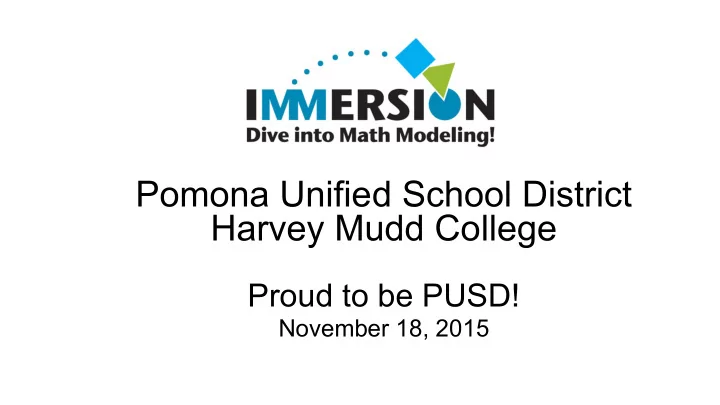

Pomona Unified School District Harvey Mudd College Proud to be PUSD! November 18, 2015
IMMERSION teachers: Please fill out the final survey you will receive by email.
Many thanks.
Gabriela Gamiz Director for Community Engagement Harvey Mudd College
Lilia Fuentes Director of Elementary Education Pomona Unified School District
Teacher Study Group Facilitators Grace Greenleaf Laura Pahler Sabrina Jordan-Ortega Stacy Brown Rachel Levy
And most importantly …
Today’s Agenda A bit about IMMERSION Teacher study groups will describe their projects Congratulatory gifts! Time to explore centers teachers rotate explain/explore
Three year project in California, Montana, Virginia National Science Foundation Grant 1441024 $1.3M How can the mathematical practice “Model with Mathematics” be enacted in the elementary grades?
Why engage elementary school students in mathematical modeling?
Mathema'cal ¡ Communica'on ¡ Vocabulary ¡ Interdisciplinary ¡ Formalizing ¡& ¡ Connec'ons ¡ Mathema'zing ¡ Mathema'cal ¡ Quan'ta've ¡ ¡ Problems ¡Solving ¡ Literacy ¡ Modeling ¡ Itera'on ¡& ¡ Crea'vity ¡ Revision ¡ Mo'vates ¡ Collabora'on ¡ Computa'on ¡ Mul'ple ¡ Cri'cal ¡Thinking ¡ Representa'ons ¡
Mathematical Modeling: The Student Cycle
Mathematical Modeling: The Teacher Cycle
Local attention for IMMERSION Superintendent Richard Martinez
National attention for IMMERSION
And now for the main event!
Group 1 Cindy Yuen Alcott 3rd Jacquelyn Coe Alcott 4th Melissa Galvan Lincoln 4th Lillian Martinez Lincoln 3rd Facilitator: Sabrina Jordan-Ortega, PUSD
Group 2 Jamie Santana Armstrong 5th Nicki Lew Pantera 5th Joe Shim Diamond Point 6th Yvette Harris Westmont 4th Mireya Jimenez Westmont 3rd/4th Facilitator: Rachel Levy, Harvey Mudd College
Carnival Fun Immersion
Carnival Games - Summary of Findings Students modeled the use of mathematical skills through the budgets they used and the rules they created. Calculations were made by hand or use of spreadsheet program. They used weights of attributes to assist in determining which game was most engaging to play. They used a ratio of success to failure as a metric to determine whether their game would be profitable. Students learned to use mathematical modeling as a way of expressing their mathematical knowledge. They reflected and revised their games to what should be improved. They engaged in various levels of SAMR and DOK. We as teachers need more time in preparing and practicing mathematical modeling tasks to be more proficient in teaching it to students. We learned that this activity could be used again next year with a few modifications such as focusing on ratios, measurement and other mathematical standards.
Group 3 Maura Cuevas Cortez 4th Marlene Harrer Cortez 3rd Diane Hubbard-Knight Cortez 4th Kristina Sandberg Cortez 4th Facilitator: Laura Pahler, PUSD (and Cortez!)
IMMERSION Project: AR Word Count Goal Maura Cuevas Diane Knight Tina Sandberg Laura Pahler Insights into teaching: The task: Student learning: ● With an authentic, open, and collaborative ● Greater understanding of place value ● Student choice in task, students of all abilities are able to find up to one million and the base ten setting Accelerated an entry point and confidently engage in system Reader goal for 1 st complex math tasks. quarter ● Greater facility with multiplication: ● When the task is relevant and meaningful, repeated addition and skip-counting ● Timed their words students show ownership and are (multiples) read per minute motivated to discuss the task in and outside of class. ● Knowledge of when and how to use ● Calculated how many ● Spreading the task over several days and “friendly” numbers (estimation) to make minutes per day and weeks gives students time to process, the task easier calendared which discuss, and adjust their calculations. days they would read ● The mathematical modeling process ● Discovered that there are different ways fosters a deep understanding of math to solve a problem and different concepts that transfers easily to a writing possible answers task.
Group 4 Robyn Clark Lexington 4th Diana Escalante Lexington 2nd Simon Hill Lexington 5th Lisa Moseley Lexington 3rd Karina Thomas-Ulrich Lexington 3rd Facilitator: Grace Greenleaf, PUSD
Our math The student The teacher modeling task: math learning: learning: Our students were tasked The students learned We learned that math with creating table to work cooperatively modeling allowed students arrangements for a given in groups to solve a to use different, various, number of people in a real world problem. and multiple strategies to banquet hall. Grades 3-5 They applied math solve the problem; and it were asked to then figure strategies to derive provided an opportunity to the cost of tables & chairs equations and multiple observe students’ for the arrangements. solutions. Students strengths & weaknesses in used tape diagrams, their mathematical number bonds, arrays, thinking, for example, Group 4 Banquet Hall number lines, and organizational skills, 5 charts.They used creating models, their & , 4 , 3 , 2 s repeated addition & approach to the problem, & e d a r G multiplication. explaining their thinking.
Group 5 Jody Britten Kingsley 5th Misael Jimenez Kingsley 4th Marka Carson Montvue 3rd Erika Villegas-Jimenez Montvue 4th Facilitator: Stacy Brown, Cal Poly Pomona
Re-Engineering Our Playground What modeling task did your students engage in? • 3rd to 5th Grade students looked at efficiency, allotment of space, elements of design, and measurement (area and perimeter, for example) in our school playgrounds at Montvue and Kingsley Elementaries. What did your students learn about mathematics and/or mathematical modeling? • Students learned that they had to make many decisions in their reasoning as they relate to math concepts. What did you learn about teaching mathematics and/or mathematical modeling? • The teaching of math modeling showed that students enjoyed the exploration, cooperation, and felt enthusiastic about the application of their learning to a real-life situation but this definitely requires constant analysis of the trajectory of the class Jody Britten, Marka Carson, Misael Jimenez, and Erika Villegas-Jimenez Kingsley and Montvue Elementary Schools
What next?
Please keep in touch…
Time to visit our centers and enjoy the refreshments!
Recommend
More recommend